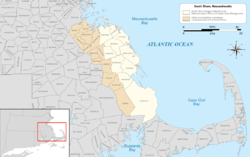South Shore (Massachusetts)
| South Shore Irish Riviera | |
|---|---|
| Region of Massachusetts | |
 The South Shore region of Massachusetts | |
| Coordinates: 42°00′N 70°45′W / 42°N 70.75°WCoordinates: 42°00′N 70°45′W / 42°N 70.75°W | |
| Country | United States |
| State | Massachusetts |
| Cities and towns | Abington, Braintree, Carver, Cohasset, Duxbury, Halifax, Hanover, Hanson, Hingham, Hull, Kingston, Marshfield, Milton, Norwell, Pembroke, Plymouth, Plympton, Quincy, Rockland, Scituate, Weymouth, Whitman |
| Area | |
| • Total | 632.9 sq mi (1,639 km2) |
| Population (2010) | |
| • Total | 541,364 |
| • Density | 860/sq mi (330/km2) |
| Largest city | Quincy (92,271) |
The South Shore of Massachusetts is a geographic region stretching south and east from Boston toward Cape Cod along the shores of Massachusetts Bay and Cape Cod Bay. It is subject to varying descriptions including municipalities in eastern Norfolk and Plymouth counties.
Depending on its geographical definition, the South Shore is composed of a mix of suburban towns, mid-sized industrial cities and rural towns. Massachusetts' heaviest concentration of Irish-American residents and descendants from ancestors from Ireland is on the South Shore,[1] and 6 of the United States' 10 most Irish towns are located on the South Shore, which is sometimes referred to locally as the "Irish Riviera."[2][3]
Geography
By its most literal definition, the South Shore includes only cities and towns between Boston and Cape Cod that physically border the Atlantic Ocean, thereby limiting the South Shore to the following:
The Massachusetts Office of Coastal Zone Management limits its definition of the South Shore to the municipalities between Boston Harbor and Cape Cod, which includes Atlantic coastal and coastal watershed areas "from the three-mile (5 km) limit of the state territorial sea to 100 feet (30 m) beyond the first major land transportation route encountered (a road, highway, rail line, etc.)."[4] This definition eliminates Braintree, Quincy and Weymouth, which border Boston Harbor, but adds the towns of Hanover, Norwell and Pembroke.[5]
In the official sense of the South Shore, however, some of these coastal communities are either members of the Boston-centered Inner Core Committee of the Metropolitan Area Planning Council (MAPC)[6] or not part of the metropolitan area at all, while the South Shore Coalition of the MAPC comprises representatives from 13 coastal and inland communities[7] and includes the following cities and towns:
Education
Institutions of higher learning which serve South Shore communities include:
- Curry College, a private four-year Liberal Arts College with the main campus located in Milton, and a satellite campus located in Plymouth.
- Bridgewater State University, a public four-year Liberal Arts College located in Bridgewater. It is the largest public university in the Massachusetts State University system outside of the University of Massachusetts system.
- Stonehill College, a private four-year Roman Catholic, Liberal Arts College located in Easton.
- Eastern Nazarene College, a private college of the liberal arts and sciences in Quincy
- Massasoit Community College, a public two-year community college with campuses in Brockton and Canton
- Quincy College, a two-year city-operated community college in Quincy
See also
- North Shore
- South Shore League, a high school athletic conference in Massachusetts
Footnotes
- ↑ Schworm, Peter. "Digging Their Celtic Roots." The Boston Globe, June 19, 2005
- ↑ "Massachusetts rules list of Irish towns". ePodunk. Retrieved 12 January 2011.
- ↑ Sweeney, Emily. "How the South Shore became the Irish Riviera". The Boston Globe. Retrieved 12 January 2011.
- ↑ "The Coastal Zone". Massachusetts Office of Coastal Zone Management. Retrieved 2009-09-05.
- ↑ "CZM's Regional Offices". Massachusetts Office of Coastal Zone Management. Retrieved 2009-09-05.
- ↑ "MAPC - Inner Core Committee:". Metropolitan Area Planning Council. Archived from the original on May 9, 2009. Retrieved 2009-05-17.
- ↑ "MAPC - South Shore Coalition". Metropolitan Area Planning Council. Archived from the original on September 27, 2007. Retrieved 2009-05-17.